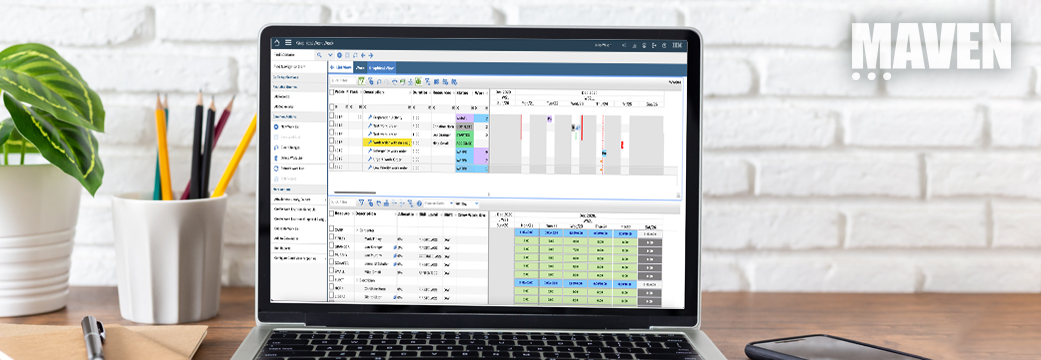Yes, you can! A few years ago, I wrote an article about data titled “You Can’t Handle the Truth.” The point of the article was that making decisions based on a gut-feel is not a best practice. We have all this data and if you reported on that data, you might not like what you see. As a result, we spend too much time reworking reports to make them (or us) look better. If we align our work processes with our strategic objectives as an organization and understand what data we have and what data we need, we can do better.
It’s all about the data.
You would be amazed at the exponential growth in the amount of data we are collecting today compared to 10 years ago. We can do so much with the massive amounts of data we are collecting, yet almost 90% (depending on what article you read) of all data is unused. With Digital Twins breathing down your neck and all the improvements in sensor technology and capabilities, you need to take a serious look at your data. Are you in control? Are your reports aligned with your strategy and objectives?
The important thing to understand is that if you are not in control of, and managing your data, you are missing out on a lot of improvement opportunities. The good news is you have several opportunities for improvement to achieve objectives that you may be struggling with.
For example, if you have a sensor on an asset that is gathering specific operational data, why guess when it may require maintenance. With tools like Maximo Manage, Monitor, Health, and Predict let the data tell you when you may need to take action, or even predict the next failure. If you are still basing you decisions on a “gut-feel” or conducting calendar-based maintenance, you are spending money on activities that may not be useful. Reading between the lines, you are wasting money and may be impacting the bottom line in a negative way. We can even make the connection that this unnecessary work also impacts our overall sustainability goals.
Let’s take a closer look.
Have you deployed sensors or are you considering deploying sensors on critical assets. How many times per hour/minute does the sensor record a parameter? What do you do with all the resulting data? The answer is, use it to trigger a work order to inspect a condition or create an algorithm based on different data points to predict a failure or set an end-of-life date for the asset. Let the systems use the data and do the work for you. You are probably thinking to yourself, it’s not that simple! What if I told you I was doing this with Maximo back in the 90s? Back then it was a brute force process, and the predictive side was based on a trend line within Excel and manual intervention. Not perfect, but the results were incredible.
If we think about the data we have at our fingertips, combined with the tools mentioned above, we can be tuned into the right station and let our data tell us of a condition that needs to be addressed – future perfect! We can use that data combined with data from other systems to generate asset health scores and predict when assets or process lines may fail.
What is the benefit? Image the work environment that is totally reactive, we have all been there, some may still be there. How much time do they have to plan for a repair? You don’t. The reactive state by definition is a constant cycle of putting out fires, never having the time to investigate a failure, to improve a process, and never getting to the point of predictive maintenance. It’s not easy, but can be done.
Some things to consider:
- It’s all about the data – do you have a data strategy in place? Are you managing your data?
- Are your Strategic Objectives aligned to your department objectives, processes, and data?
- Do you have an asset criticality matrix in place, and is criticality assigned to each asset?
- Do you have proper and up-to-date job plans in place?
- When was the last time you reviewed your job plans?
- What type of sensors do you have in place?
- What data are you collecting with the sensors?
- What are you doing with the data?
In order to trust your data, you need to understand your data. If you feel the quality and completeness of your data is impacting your operations, I suggest you identify targets and expectations and capture baseline information to support trending. Use the information to take meaningful action instead of merely posting reports.
If you’d like to have a further discussion about data and how you can handle the truth buried in your data, give me a call, and I’d be happy to have a conversation.
The bottom line is that with the new software applications and technologies that are available to us, our ability to listen and tune into our data has never been more powerful. An investment in these tools will not only provide a return for years to come, but it will also help us advance on the maintenance maturity continuum in great strides and move more towards a future perfect world of maintenance and operations that will have a positive impact on our operations, our people, and the environment.
Are you interested in reading my original “You Can’t Handle the Truth” Article?
Below is the text from my previously written and published article for your convenience.
“You Can’t Handle the Truth.”
Remember that scene in the movie “A Few Good Men” when Jack Nicholas (the movie star, not Jack Nicholas Jr., the reliability guru) was being questioned by a young lawyer played by Tom Cruise about a specific incident. Cruise kept pressing and Nicholas hits his breaking point and yells out “You can’t handle the Truth.” Sometimes, I feel that this is what I would say to myself based on the data that we are able to track today. The data may tell you something you might not want to know… If you are on the quest for increased asset performance, moving into the IoT world, or trying to move up the maintenance maturity continuum, you absolutely need to know what the data is saying. You absolutely need to hear the truth so you can take the appropriate action. So, how do we do that?
Decision Making – Gut Feel or Based on Data
When I was a kid, I used to think about building things, which led to … building things. Both of my grandfathers were big influences in those early days, and I was always asking them questions. I think back on those days and some of the answers they gave me and realize now that it was all about data and experience. In one case we were building a model sailboat out of scrap wood and I asked what would happen if we put the mast more towards the back of the boat. “Not sure” was the answer. We didn’t have any data or experience building sailboats to draw a meaningful conclusion from. So, we tried it. We launched the boat with a line attached to it and it didn’t work very well. It only went in circles due to the forces on the back of the boat. If we knew what would happen based on empirical data, “The Truth,” we would have come up with a different plan.
Fast forward a bunch of years and the point is, how many decisions do we make in our day-to-day and work life without the right data, or how often do we NOT want to know the truth our data contains? How many of those decisions turned out the way we, or others, expected? Sometimes we make decisions based on our instincts, or gut feel. However, today, we have so much information at our fingertips, we should be using it to make better decisions. My wife and I had a heated discussion the other day because I missed a turn. Sure, the maps application on my phone was telling me to turn in a mile, ½ mile, 200 yards, recalculating. If only I had the volume turned up, I would have heard it.
As W. Edwards Deming said, “Without data, you’re just another person with an opinion.”
Outcomes Aligned with Objectives
How often do we set objectives for ourselves and hope they go the way we plan? We all know that “hope is not a strategy,” but we all continue to use hope in explaining desired outcomes. Why not listen to the information and data we have readily available so that we can track and ensure our objectives can be met? Sounds simple enough, right? Visibility of all the moving parts is where things start to break down. We may be collecting the right information either automatically or manually, but can we see it in a way that makes sense? Are we using a custom spreadsheet that someone else put together that has to be updated every time we want to use it? How much additional time are we spending trying to see the data we have?
Are we tuned into the right station? Are we tracking the right metrics and KPIs? Is the data aligned with our processes and what our folks are doing? Have we identified the right data to track? How do we track this data against our objective? What data do we even track? Do we do anything with it? All simple questions, but sometimes very difficult and time consuming to answer. Throughout my life, I have always understood, “if you don’t measure it, you can’t improve it.” This should be etched in stone and given to everyone entering the work force no matter what your role is. If you set an objective for the organization, let everyone know how they will impact and be impacted by the objective, and why it is important to the organization. I recently taught a class on planning and scheduling and was asking about processes and if they were defined and documented and the conversation took a turn I was not expecting. A simple question led to a discussion on why we are doing what we are doing and how it impacts the entire organization. When we are heads down, getting the work done, sometimes we don’t look up and see how our actions impact the organization and its ultimate goals. In my opinion, it is Leadership’s responsibility to make sure everyone understands their role and how they fit into the bigger picture.
Data Quality
Data Quality is the condition of a set of values of qualitative or quantitative variables. There are many definitions of data quality, but data is generally considered high quality if it is fit for its intended uses in operations, decision making and planning.
How is the quality of your data? Do you have a data strategy identified? I always get a lot of sighs and groans when we start talking data. You would figure that in this day and age when we have the ability to produce mountains of data, that our data would be much better than it is. The problem is, what we are collecting is not always aligned with our objectives, and may not be structured properly. Garbage in equals garbage out, right. There are many ways to ensure you are capturing data properly such as with the use of mobile devices and SCADA systems? Data Historians? IoT and Digital Twins?
Gartner estimates that there will be 20.4 billion IoT devices by 2020 (we are there now) creating more than 500 zettabytes per year in data. Excuse me, but based on the data I have seen, we need to make sure we are setting this up right because I’m not sure what a zettabyte is, and I surely wouldn’t want to clean up that much data! And to be clear, I have cleaned a lot of data in my days and seriously would rather go to the dentist or other -ist!
Data Confidence
Data Confidence, on the other hand, is the level of trust an organization can place in data based on characteristics such as System and Process Integrity, Completeness, Currency, and Governance. In other words, I may have the data to measure specific points, but does that data support the decisions I must make against the established objectives. If I am trying to improve planning effectiveness and the quality of the data I have is good, that should equate to top shelf metrics. What if I am not capturing actual hours on my work orders? I would have no confidence in the ability of my data to provide an accurate indicator of the effectiveness of my team’s ability to plan the work.
As W. Edwards Deming said, “In God we trust, all others must bring data.” Make sure your folks are collecting the right data based on the KPIs you need to support your objectives.
Conclusion
The data that can be found in our business systems is what it is. What we need to be able to do is easily visualize our data such that we can clearly see where we stand against our objectives. That assumes our objectives are clearly defined. Using excel spreadsheets to run our business doesn’t work anymore. So why do we continue to use Excel spreadsheets to massage and manipulate our data to try and show where we are on our journey?
Start with your Strategic Objectives to ensure you have the right KPIs. Bridge the gap between Strategy and Execution by aligning your objectives, processes, and data to ensure the KPIs are relevant and usable. Trust your data which may require an understanding of your data and possible cleansing. Identify targets and expectations and capture baseline information to support trending. Use the information to take meaningful action instead of merely posting reports.
Until then, turn up the volume on your navigation app and your data, so you don’t miss the next turn.







